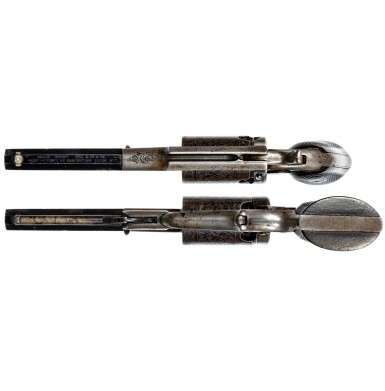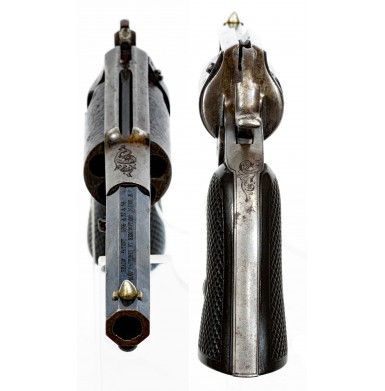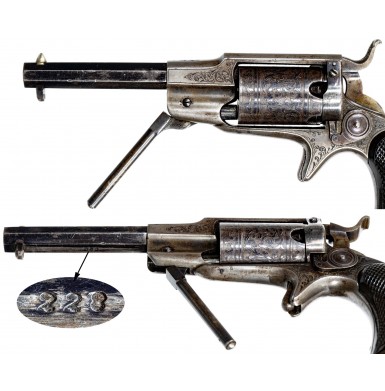Fine Factory Engraved 3rd Model Remington-Beals Pocket Revolver
- Product Code: FHG-2239-SOLD
- Availability: Out Of Stock
-
$1.00
The 1850s were an exciting and important time for the design and production of percussion revolvers in the United States. Samuel Colt had proven the concept viable with his Paterson series of revolving firearms. His subsequent Walker and Dragoon series of large bore percussion revolvers had further proven the viability of the percussion revolver as a military weapon. Thus, Colt had created a market in America for percussion revolving pistols that he could not begin to fill and that he also had complete control of. His patent that covered the way in which his revolvers operated would not expire until 1857 and this hamstrung the numerous small firearms manufacturers who were attempting to offer percussion revolvers that Colt could not produce quickly enough. In fact, during the mid-1850s Colt probably spent as much time defending his patent rights in court as he did running his company.
On September 26, 1854, 47-year-old Fordyce Beals received US Patent #11,715 for a revolver design that essentially evaded Colt’s patent. Colt’s patent centered on the fact that the cocking motion of the hammer also revolved the cylinder, bringing a fresh chamber in line with the barrel and making the revolver ready to fire with the simple pull of the trigger. Other designers had evaded Colt’s patent around the same time by creating revolvers that had manually rotated cylinders. While functional, it was a slow process to rotate the cylinder manually, cock the hammer and then fire the pistol. This was also more difficult as the revolver was fired and the cylinder heated up. Fordyce Beals’ design solved the problem by rotating the cylinder from the action of the trigger. The hammer still needed to be cocked manually, but the simple and elegant solution allowed the hammer to be cocked and then the ring trigger pulled, which rotated the cylinder, aligning a fresh chamber and then fired the pistol. In essence it was also a predecessor to the double action revolver action. Beals had previously worked for the Remington Arms Company, but in 1854 moved to the Whitney Arms Company where his new design would be produced. The revolver would be known as the “Walking Beam” Revolver and was one of the first revolvers produced by Whitney in quantity.
In 1856, Beals returned to his former employer Remington, and almost immediately Remington entered the percussion revolver market. Beals’ first design for the firm was based upon his US Patent #15,167, which was granted on June 24, 1856 and his US Patent #17,359 which as granted on May 26, 1857. This design resulted in what collectors refer to as the Remington-Beals 1st Model Pocket Revolver. The gun was a five-shot, single action .31 caliber solid frame percussion revolver with a 3” octagonal barrel and a smooth cylinder. The revolver had a conventional trigger and triggerguard with the most unique design feature being the external pawl on the left side of the frame that rotated the cylinder when the hammer was cocked. The silhouette of the revolver was instantly identifiable due to the hump-back shape of the rear portion of the topstrap. The revolvers were blued with smooth composite hard rubber, often call “gutta percha”, round butt grips. Between the gun’s introduction in 1857 and the end of its roughly one-year production life, between 4,500 and 5,000 were produced by Remington. The design was somewhat fragile and had limited applications due to the lack of a loading lever. As a military revolver it had no application at all due to its size, but it was certainly a popular and successful personal protection revolver. A very small number of massive .44 caliber versions of the revolver were produced as experimental arms for submission to the US military, but nothing appears to have come of this design.
In 1858, Remington introduced an improved version of the Beals Pocket revolver, referred to by collectors as the 2ndModel Remington-Beals Pocket Revolver. This new version adopted a sheathed spur trigger to replace the conventional triggers of the 1st Model Revolvers. It also adopted a square butt design for the frame. For all practical purposes the new pattern retained the same mechanism with the external pawl and lack of loading lever as the 1st Model Revolvers. The 2ndModels were also .31 caliber with 3” barrels and five-shot cylinders. During the year that these revolvers were produced, from 1858-1859, about 1,000 2nd Model Revolvers were produced. Like the first model guns, the 2nd Model guns were blued with either hard rubber or walnut grips.
In September of 1858, Beals received another US Patent, #21,478. This patent covered his newly designed integral loading lever, which was secured under the barrel with ball detent system. Beals applied his new loading lever to a redesign of the 2nd Model Pocket Revolver and this resulted in the 3rd Model Remington-Beals Pocket Revolver. The gun retained the square butt profile, spur trigger and basic mechanical design of its immediate predecessor but was enlarged. The octagonal barrel was lengthened from 3” to 4” and the earlier production cylinder that was only 1 1/8” in length was lengthened ½” to 1 5/8”. This allowed more powder to be loaded into the chamber, increasing the muzzle velocity and muzzle energy of the revolver. As the earlier guns did not have loading levers, the cylinder arbor pin was retained by a spring catch system. With the new loading lever, the arbor pin was retained by the loading lever and lowering the lever allowed its removal. The arbor pin had a single “wing” at the front to allow removal once the lever was down. This same “single wing” system was used on the early production Beals Navy revolvers but was soon replaced with the more traditional Remington double wing arbor pin. In many ways, the new 3rd Model Revolver had an appearance much like a shrunken Beals Model Navy or Army revolver, and clearly represents a step in that direction of design. Like the 2ndModel, only about 1,000 of the 3rd Model Remington-Beals Pocket Revolvers were produced during their roughly one-year of production from 1859-1860. The guns were superseded by the double action Remington-Rider revolver during 1860, which would remain in production through 1873. However, the eruption of the American Civil War in April 1861 would significantly curtail the production of civilian pocket pistols at the Remington factory, as the firm concentrated on producing military sized handguns, as well as military pattern rifles and rifle muskets.
Offered here is a VERY FINE and scarce Factory Engraved 3rd Model Remington-Beals Revolver. Like all of the Remington-Beals patent pocket revolvers, it is a 5-shot, single action, solid frame, percussion ignition revolver. The four-inch octagonal barrel is marked in two lines on the top flat:
BEALS’ PATENT 1856 & ,57. & ’58.
MANUFACTURED BY REMINGTONS’ ILION, NY.
The revolver is serial numbered 228 under the barrel (concealed by the loading lever), on the left side of the frame under the grip and in the right grip. The gun is a high grade, factory embellished revolver with an acid-etched cylinder that is decorated with foliate scrolls and decorative lines. The frame is engraved with neatly executed flowing foliate scrolls behind the recoil shield, down onto the trigger sheath, on the upper portion of the backstrap and on the upper portion of the frame forward of the cylinder. The revolvers retains about 50% of its original bright blued finish overall, with the majority on the octagonal barrel, a moderate amount on the cylinder and some strong traces on the frame. The finish loss on the frame appears to be from flaking, while the loss on the cylinder appears to be both from flaking and thinning due to wear. The barrel shows some loss along the sharp edges and contact points, as well as some scattered minor patches of surface oxidation and some minor impact marks along the sharp edges. The metal is almost entirely smooth throughout, with only the aforementioned scattered light surface oxidation on the barrel resulting in any roughness. The hammer retains about 70%+ vibrant case colors, with the right side retaining nearly all of the vivid colors and the left side having a dulled and muted appearance with a grayish-brown patina and some more muted color. All of the markings and engraving on the pistol remain clear and crisp and are in fine condition. The original German silver cone front sight is in place in the dovetail on the top of the barrel, near the muzzle. The original Beals patent loading lever is in place under the barrel and functions smoothly. The lever also locks tightly into place when not in use. The checkered hard rubber grips are in about EXCELLENT condition and are free of any breaks, cracks or chips. The grips have a lovely chocolate brown color with crisp checkering and show only the most minor light wear marks. These brittle grips are often chipped and damaged, so it is nice to see a revolver with retains really fine, crisp grips. The gun remains mechanically excellent and functions perfectly. The revolver times, indexes and locks up perfectly and the action remains quite tight and crisp. The bore of the revolver is in about FINE condition. It is mostly bright with strong rifling but does show some oxidized patches of discoloration and minor roughness. Some of this may be old dirt that could brush out, improving the bore.
Overall this is a really wonderful condition and very attractive example of a Factory Engraved 3rd Model Remington-Beals Pocket Revolver. These revolvers were produced in relatively small numbers immediately before the Civil War and are scarce on their own, whether embellished or plain. Many no doubt went off to war int eh pockets of young soldiers, which explains why some many surviving examples are in rough condition. This is a really lovely example with crisp engraving on the frame and acid etching on the cylinder that would be a fine addition to any advanced collection of Remington revolvers or Civil War era pocket handguns.
SOLD
Tags: Fine, Factory, Engraved, 3rd, Model, Remington, Beals, Pocket, Revolver










